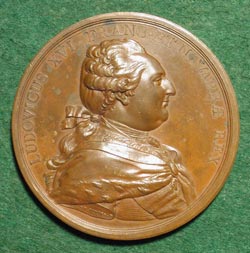

|
NEW BREAKWATER FOR CHERBOURG HARBOR DUVIVIER, Benjamin: France, 1786, Bronze, 69 mm Cherbourg is a harbor in northwestern France, located in Normandy, at the entrance to the English Channel. It is accessed by way of a triangular bay which is naturally sheltered on every side but the north. It was here that a huge breakwater, over two miles in length, was built by running across the open sea a series of 20 wooden cones, each 50 meters in diameter at their base and 20 to 24 meters in height, which were then filled with masonry. Work began in 1783. Louis XVI attended the immersion of the ninth cone on June 23, 1786, the event commemorated by this medal. The last cone was cast in 1788, but the project was abandoned during the French Revolution. Work began again under Napoleon who decided to resume its construction to provide a fort of defense. The dam was continued by Louis Phillipe and Napoleon III and was finally completed in 1853. It was further extended in 1889. The construction of the breakwater at Cherbourg resulted in the largest artificial harbor ever built, and its creation is considered to be one of the greatest achievements of the 18th and 19th centuries. Cherbourg is now a port of call for transatlantic steamers.
|
|